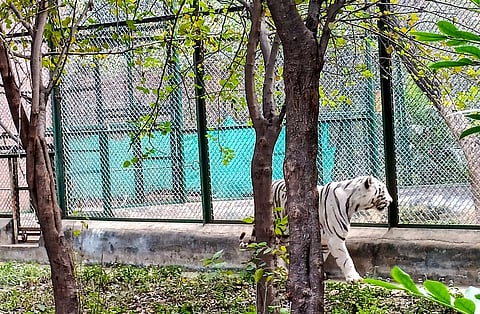

Three tigers and a leopard have died after getting infected from Highly Pathogenic Avian Influenza (HPAI) H5N1 virus, commonly known as ‘bird flu’, at the Balasaheb Thackeray Gorewada International Zoological Park in Nagpur.
As per a report published in The Times of India, the animals were rescued from the wild in December from Chandrapur, following instances of human-animal conflict.
This is the first instance of the disease having caused mortality among captive wildlife in India.
The development has forced authorities in Maharashtra to issue a red alert for other zoos in the state. The authorities have called for an immediate suspension of all transfers of animals within and outside the facility.
According to the letter issued by the zoo, its Chief Executive Officer (CEO) Chandrasekaran Bala N informed the additional principal chief conservator of forest that following the deaths, samples were sent to the ICAR-National Institute of High Security Animal Diseases in Bhopal on December 31, 2024.
H5N1, which was first reported in poultry birds in recent years, has “spilled over into wildlife” to infect over 500 species and at least 70 mammalian species, the United Nations has said.
The virus has established its presence in 108 countries, across five continents and reached the far ends of the world to infect polar bears and Antarctica penguins.
The samples of four tigers and two leopards were received on by ICAR-NIHSAD on January 1, 2025. Three tigers and two leopards tested positive for the H5N1 avian influenza virus. A male tiger tested negative, though.
The incident has prompted the Wildlife Research and Training Centre (WRTC) to issue an advisory outlining the necessary measures to contain the spread of avian influenza (H5N1) at zoos, rescue centres and transit treatment centres, the letter said.
The copy of the letter, accessed by Down To Earth, does not talk about the source of the infection and whether the strain was 2.3.4.4b. The strain has caused fatalities and disease in wildlife and livestock globally and infected humans as well.
The WRTC has prepared a comprehensive advisory and plan of action to curb the spread of the disease. “The same can be forwarded to zoos and rescue centres in the state and neighbouring states to contain the spread and early detection of H5N1 in wild animals,” a letter from WRTC to the CEO of Gorewada zoo stated.
The action plan includes biosecurity measures to prevent access of birds to other animals, with the use of nets and covers. Maintaining hygiene and disinfecting footwear and equipment are other protocols that have been put in place.
The measures also include avoiding feeding carnivores raw poultry or other meat products from unknown or unverified sources. The WRTC has also called for regular monitoring of animals’ health, especially signs of unusual behaviour or symptoms that indicate avian influenza.
On January 3, the Animal Husbandry Commissioner, Abhijit Mitra, wrote to the chief secretary of the Government of Maharashtra to isolate infected or symptomatic tigers and other feline species or any other animals to prevent further transmission.
Such facilities have been directed to temporarily shut down for the public and increase biosecurity measures.
The letter stated that the deaths of tigers and leopards that had tested positive for HPAI raises serious concerns about the rapid spread of the virus.
“The situation demands urgent attention to mitigate risks to both animal and human health. It is requested that the One-health approach be implemented, integrating the efforts across various sectors, including human health and wildlife, to address the issue in comprehensive manner,” the letter said.